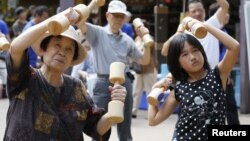BANGKOK —
Researchers in Asia are warning that aging populations pose challenges for governments, as economic productivity falls and more people need financial and medical support. Governments are beginning to heed the warning, pursuing a range of policies to try to address the problem.
In Singapore this year, the government unveiled a catchy song to address a topic that usually does not have dedicated state-sponsored jingles: the island state's young couples need to produce more children to help reverse declining fertility rates.
The song is light-hearted, but the problem is serious. By 2030, the population will halve within a generation as the elderly are set to triple in number. As an incentive, Singapore is offering bonuses of up to $3,250 for each of the first two children, rising to nearly $5,000 for the third and fourth offspring.
Through the 1980s and on, Asia's young working age population was a driving force for the region's economic success. But the trend in Singapore is symptomatic of broader shifts across Asia Asian Development Bank (ADB), said economist Donghyum Park.
“The share of the elderly - those aged 65 plus in total population - as well as relative working age population is steadily increasing across developing Asia. Asia is no different from the advanced economies that experienced its demographic transition much earlier," he said.
In Japan in 2010, more than 22 percent of the population was aged more than 65 years.
In Thailand, the population older than 65 years has risen to just over 7.0 percent in 2010 from 3.6 percent in 1975.
Thailand's family planning’s successes led to dramatically smaller families. In the 1960s, mothers had on average five to six children. Now, that figure has fallen to 1.5 children, well below the “replacement level” to hold the population steady.
For Vipan Prachuabmoh, dean of population studies at Chulalongkorn University, the population decline threatens to have a longer term economic impact.
“We are concerned that we will have a decline in the number of the population in the labor force age, so the numbers are starting to decline," said Vipan. "We [also] have a very sharp rise in terms of number and the proportion of population in the old age group. So now we start to concern about the sustainability, development of the country because we still have a problem in terms of human capital.”
The problem for governments is that boosting population growth to maintain productivity also has downsides.
According to Vipan, those challenges include reform to the education system, raising labor skills and preparing a new generation for an aging society. This, she said, also requires greater savings to ensure quality of life.
In Indonesia, Siswanto Agus Wilopo, chair of the Center for Reproductive Health at Yogyakarta’s Universitas Gadjah Mada, also recommends similar policies aimed at quality of life - that could differ country by country.
“We have to recognize that there are variations - geographic variations and secondly, to deal with the older population and declining population and the need for different interventions," Siswanto said. "So we cannot take a single prescription across Asia, or within the country. We have to move slowly.”
China and India have long pursued a harder line to tackle population growth through family planning programs. But researchers warn that those also carry long-term implications.
Sex selection and the intervention of medical technology have led to gender gaps of 117 million women “missing” largely in China and India, according to the United Nations Population Fund (UNFPA).
Therefore, UNFPA has forecast that, by 2030, China and India will have 50 percent more men than women of marriageable age.
Progress has been achieved in balancing population growth with fertility rates, said Wolfgang Lutz, from the Vienna-based Wittgenstein Center. But the challenges are ongoing.
“It really depends on adding what some people call the quality - meaning, the focus on human capital, on education - on education and health rather than just the head count," said Lutz. "A lot of countries have made a lot of progress and when re-evaluating evidence in declines of fertility - education - especially the education of girls - has been one of the driving factors.”
The Asian Development Bank says this focus on education is a key solution for tackling the aging workforce. A better educated and trained work force can boost productivity - meaning stronger economic growth - despite the smaller proportion of working-age citizens.
In Singapore this year, the government unveiled a catchy song to address a topic that usually does not have dedicated state-sponsored jingles: the island state's young couples need to produce more children to help reverse declining fertility rates.
The song is light-hearted, but the problem is serious. By 2030, the population will halve within a generation as the elderly are set to triple in number. As an incentive, Singapore is offering bonuses of up to $3,250 for each of the first two children, rising to nearly $5,000 for the third and fourth offspring.
Through the 1980s and on, Asia's young working age population was a driving force for the region's economic success. But the trend in Singapore is symptomatic of broader shifts across Asia Asian Development Bank (ADB), said economist Donghyum Park.
“The share of the elderly - those aged 65 plus in total population - as well as relative working age population is steadily increasing across developing Asia. Asia is no different from the advanced economies that experienced its demographic transition much earlier," he said.
In Japan in 2010, more than 22 percent of the population was aged more than 65 years.
In Thailand, the population older than 65 years has risen to just over 7.0 percent in 2010 from 3.6 percent in 1975.
Thailand's family planning’s successes led to dramatically smaller families. In the 1960s, mothers had on average five to six children. Now, that figure has fallen to 1.5 children, well below the “replacement level” to hold the population steady.
For Vipan Prachuabmoh, dean of population studies at Chulalongkorn University, the population decline threatens to have a longer term economic impact.
“We are concerned that we will have a decline in the number of the population in the labor force age, so the numbers are starting to decline," said Vipan. "We [also] have a very sharp rise in terms of number and the proportion of population in the old age group. So now we start to concern about the sustainability, development of the country because we still have a problem in terms of human capital.”
The problem for governments is that boosting population growth to maintain productivity also has downsides.
According to Vipan, those challenges include reform to the education system, raising labor skills and preparing a new generation for an aging society. This, she said, also requires greater savings to ensure quality of life.
In Indonesia, Siswanto Agus Wilopo, chair of the Center for Reproductive Health at Yogyakarta’s Universitas Gadjah Mada, also recommends similar policies aimed at quality of life - that could differ country by country.
“We have to recognize that there are variations - geographic variations and secondly, to deal with the older population and declining population and the need for different interventions," Siswanto said. "So we cannot take a single prescription across Asia, or within the country. We have to move slowly.”
China and India have long pursued a harder line to tackle population growth through family planning programs. But researchers warn that those also carry long-term implications.
Sex selection and the intervention of medical technology have led to gender gaps of 117 million women “missing” largely in China and India, according to the United Nations Population Fund (UNFPA).
Therefore, UNFPA has forecast that, by 2030, China and India will have 50 percent more men than women of marriageable age.
Progress has been achieved in balancing population growth with fertility rates, said Wolfgang Lutz, from the Vienna-based Wittgenstein Center. But the challenges are ongoing.
“It really depends on adding what some people call the quality - meaning, the focus on human capital, on education - on education and health rather than just the head count," said Lutz. "A lot of countries have made a lot of progress and when re-evaluating evidence in declines of fertility - education - especially the education of girls - has been one of the driving factors.”
The Asian Development Bank says this focus on education is a key solution for tackling the aging workforce. A better educated and trained work force can boost productivity - meaning stronger economic growth - despite the smaller proportion of working-age citizens.








